Egg and Daughter Nite
Official Video for John Prine’s “Egg & Daughter Nite, Lincoln, Nebraska, 1967 (Crazy Bone) from his last album, ‘The Tree of Forgiveness.
If you’d like to put a smile on your face, click on the red Play Arrow above. The sound is sublime, the words are clever and funny and quirky, and the cartoon is hilarious.
As noted on the blog a while back (type John Prine into the little whites each box on the upper right of each page), it is hard to believe that I existed on this planet for more than 75 years without having ever heard of John Prine.
Note: Prine’s voice became raspy late in life after two throat cancer surgeries.
Ryan Hamilton of Ryan Hamilton & The Harlequin Ghosts
John Prine was already a genius songwriter. But as he got older and his voice aged along with him, he just kept getting better. The older, more gravelly version of his voice just gave his songs even more of a timeless, story vibe. It also made his voice sound more like home. I will forever be sad that I never got to meet him, but all songwriters should be thankful we have John Prine to look to for an endless well of inspiration.
“Egg & Daughter Nite” – The story behind why this song was written (which he told often) is entertaining enough! Put that aside, and the fact that the man can even write a beautiful song with the lyrics, “Egg & Daughter Nite”, is yet another feather in John Prine’s cap of songwriting genius.
From a Jon Prine interview by Jon Bernstein here on The Guardian website.
John Prine was sitting in a boat in the middle of a river when he realized he had an idea for a song.
The idea came the way ideas usually come for Prine: by listening. This time, he was listening to his fishing buddy, John Earl, a former guitar tech for the Everly Brothers, tell him a story about growing up in Norfolk, Nebraska, in the 40s and 50s.
“He told me that on Thursday nights, him and his buddies used to go to the roller rink and the egg farmers would come in from the country and they’d drop their daughters off, go sell their eggs, and then these big city guys would make time with the farmer’s daughters,” says Prine, 71. The weekly event, Prine says, was formerly known as Egg and Daughter Night: “I just thought the title of it was so good.”
Prine is laughing now, still amazed and amused by this curious slice of Americana, the very sort of oddball premise he’s used to stage the heart-wrenching, thigh-slapping quirky folk dramas he’s been writing for the past 50 years.
“It’s a very American story,” he says, as if to explain why he was so drawn to the anecdote in the first place.
The resulting song, Egg & Daughter Nite, Lincoln Nebraska, 1967 (Crazy Bone) serves as one of the centerpieces to The Tree of Forgiveness, Prine’s first record of original material since 2005.
Across the LP, Prine blends goofball wit and aw-shucks surrealism to conjure the ordinary and the profound, absurdist whimsy and existential despair, laughter and tears. These juxtapositions have long been the songwriter’s trademark, and on his latest, he places references to Easter eggs and a “funky sushi bar” among lyrics about despondency and disaster.
“Midwestern mind-trips to the nth degree,” is how Bob Dylan once explained Prine’s music. Prine himself began earning Dylan comparisons when he released his 1971 self-titled debut album, which included folk classics like Sam Stone and Angel From Montgomery, but the Chicago singer-songwriter quickly forged his own path.
Canon EF 100-400mm f/4.5-5.6L IS II USM Lens
BAA Record-low Price!
Tom Torget is offering a Canon EF 100-400mm f/4.5-5.6L IS II USM lens in near mint condition for a very low $1,099.00. The sale includes the front and rear lens caps, the lens hood, a Wimberley lens plate, the carrying case, the original product box, and insured ground shipping via major courier to lower-48 addresses only.
Please contact Tom via e-mail or by phone at 1-830-377-5483 (Central time).
This incredibly versatile zoom lens — with its amazing .98-meter close focus — was my favorite Canon telephoto zoom lens ever. By far. It is easy to hand hold, great for tight portraits, for birds in flight, for quasi-macro stuff, and lots more. For flight, it is deadly with an EOS R, R3, R5, R6, or R7! This lens sells new for $2399.00 so you can save a handsome $1300.00 by grabbing Tom’s lens right now. artie
My Call
In the previous blog post, all three soft-light Snowy Egret images garnered at least one vote. Though I liked all three of them, I was not entirely happy with the relatively inconsistent image optimizations.
Your Call
Be sure to let us know which version (if any), of today’s featured image you like best, and why you made your choice.
What’s Up?
I am headed up to Long Island within the week (not sure when or how) to have my trigger finger (right index finger) surgically repaired by Dr. Stephen Populo. Dr. “Pop” bailed me out a dozen years ago with debridement surgery to clear up an infection that resulted from a previous trigger surgery (left middle finger) done by a guy in Orlando. My pre-op visit is on 23 May, the surgery two days later. Good luck to me.
Today is Monday 15 May 2023. I have quite a few loose ends to tie up before I head north. Wherever you are and whatever you are doing, I hope that you too have a great day.
Please remember to use the B&H and Amazon links that are found on most blog pages and to use the BIRDSASART discount code at checkout when purchasing your new gear from Bedfords to get 3% back on your credit card and enjoy free second-day air FedEx. Please, also, consider joining a BAA IPT. You will be amazed at how much you will learn!
You can find some great photo accessories (and necessities, like surf booties!) on Amazon by clicking on the Stuff tab on the orange/yellow menu bar above. On a related note, it would be extremely helpful if blog-folks who, like me, spend too much money on Amazon, would get in the habit of clicking on the Amazon logo link on the right side of each blog post when they shop online. As you might expect, doing so will not cost you a single penny, but would be appreciated tremendously by yours truly. And doing so, works seamlessly with your Amazon Prime account.
Please remember that if an item — a Delkin flash card, or a tripod head — for example, that is available from B&H and/or Bedfords, is also available in the BAA Online Store, it would be great, and greatly appreciated, if you would opt to purchase from us. We will match any price. Please remember also to use my B&H affiliate links or to earn 3% cash back at Bedfords by using the BIRDSASART discount code at checkout for your major gear purchases. Doing either often earns you free guides and/or discounts. And always earns my great appreciation.
The Fact$ of Life
Right now, the market for editorial sales of natural history images has virtually disappeared. The incomes of the world’s top stock photographers are down by at least 90%. Like me, most depend on income from photo trips, the sale of educational materials, and income from this or that affiliate program.
In 2001, BAA sold the publication rights to images for nearly one-quarter million US dollars. That amount dropped to about $20,000 by 2011, and in 2017, to slightly more than $2,000.00. We’ve stopped counting. IPTs used to fill within days. Now I am happy to go with one or two folks, but I’d much rather have you along. And so it goes. In 2009, I turned to creating educational blog posts, now to the tune of 4009. Yes, 4009 educational blog posts. So, please remember to use either my B&H or Bedfords affiliate links for your major purposes. It does not cost you one cent to do either.
|
|
|
This image was created on 24 December 2022 at La Jolla, CA. Standing at full height, I used the Robus RC-5558-3 Vantage Series 3 Carbon Fiber Tripod/Levered-Clamp FlexShooter Pro-mounted Sony FE 600mm f/4 GM OSS lens with the Sony FE 1.4x Teleconverter, and The One, the Sony Alpha 1 Mirrorless Digital Camera.. ISO 2500. The exposure was determined by Zebras with ISO on the rear wheel: 1/125 second at f/5.6 (wide open) in Manual mode. RawDigger showed that the raw file brightness was about 1/3-stop too dark. AWB at 6:45:48am two minutes before the time of sunrise on a cloudy morning. Tracking: Zone//AF-C with Bird-Eye/Face Detection performed perfectly. Click on the image to enjoy the high-res version. Image #1: Ring-necked Duck drake swimming in swirly, pre-dawn water |
The Color Version
On all IPTs, I get the group out early to seek unique opportunities. We were in position to take advantage of “fire-in-the-mist” conditions at Santee Lakes. but before the sun crested the distant hills to the east, I noted a handsome drake ring-necked swimming through dark swirly water. Realizing that patterns on the water surface are better shown by standing, I fired off a few slow shutter speed frames in hopes of making one or two sharp ones.
Though Image #1 could not be described as having vibrant colors, it is indeed the color version. You can see a bit of purple on the duck’s head and a bit of green in the water.
|
|
Image #2: This is a Black and White version of Image #1: Ring-necked Duck drake swimming in swirly, pre-dawn water |
The Black and White Version
As Image #1 was dark and relatively achromatic, I decided to create a black and white version and see how it looked. Working on a layer, I went Filter > NIK Collection > Silver Efex Pro 3. After trying many different pre-sets, I opted for 015, Full Dynamic (harsh), and pulled back the Dynamic Brightness slider to make the dark tones darker.
|
|
Image #3: This is a version of Image #2 with the orange eye painted back in: B&W Ring-necked Duck drake swimming in swirly, pre-dawn water |
Bringing Back the Duck’s Orange Eye
Having applied the B&W filter on a layer, I simply added a Regular Layer Mask and painted in the duck’s orange eye. Then, using Tim Grey Dodge and Burn, I darkened the lower half of the pupil. All of the above (and tons more) as detailed in Digital Basics II.
|
|
|
San Diego offers a wealth of very attractive natural history subjects, including and especially the Pacific race of California Brown Pelican. With annual visits spanning more than four decades, I have lots of photographic experience there … Click on the composite to enjoy a larger version. |
The 2023/2024 San Diego Brown Pelicans (and more!) IPTs
San Diego IPT #1. 3 1/2 DAYS: WED 27 DEC thru the morning session on Saturday 30 DEC 2023. $2099.00. Deposit: $699.00. Limit: 6 photographers.
San Diego IPT #2. 4 1/2 DAYS: TUES 9 JAN thru the morning session on SAT 13 JAN 2024: $2699.00. Deposit: $699.00. Limit: 6 photographers.
San Diego IPT #3: 4 1/2 DAYS: TEUS 23 JAN thru the morning session on SAT 27 JAN 2024: $2699.00. Deposit: $699.00. Limit: 6 photographers.
Please e-mail for information on personalized pre- and post-IPT morning sessions.
Join me in San Diego to photograph the spectacular breeding plumage Brown Pelicans with their fire-engine red and olive green bill pouches; Brandt’s (nesting) and Double-crested Cormorants; breeding plumage Wood and Ring-necked Ducks; other duck species possible including Lesser Scaup, Redhead, Northern Shoveler and Surf Scoter; a variety of gulls including Western, California, and the gorgeous Heermann’s, all in full breeding plumage; shorebirds including Marbled Godwit, Willet, Sanderling and Black-bellied Plover; many others are possible including Least, Western, and Spotted Sandpiper, Whimbrel, Black and Ruddy Turnstone, Semipalmated Plover, and Surfbird; Harbor Seals and California Sea Lions (both depending on the current regulations and restrictions). And as you can see by studying the IPT cards, there are some nice bird-scape and landscape opportunities as well. Not to mention a ton of excellent flight photography opportunities and instruction.
I discovered some really neat spots on my 2022/23 visit. As a result, the first and second IPTs may include an afternoon or two of landscape photography.
Please note: where permitted and on occasion, ducks and gulls may be attracted (or re-located) with offerings of grains or healthy bread.
Learning Exposure, and learning to work in Manual Exposure Mode, Whether You Like It Or Not
Whether you like it or not, we will be beating the subject of exposure like a dead horse. In every new situation, you will hear my thoughts on exposure along with my thoughts on both Nikon and Canon histograms and SONY Zebras. Whether you like it or not, you will learn to work in manual mode so that you can get the right exposure every time (as long as a bird gives you ten seconds with the light constant). Or two seconds with SONY zebras … And you will learn what to do when the light is changing constantly. What you learn about exposure will be one of the great takeaways on every IPT.
|
|
|
Though the pelicans will be the stars of the show on this IPT, there will be many other handsome and captivating subjects in wonderful settings. Click on the composite to enjoy a larger version. |
It Ain’t Just Pelicans
With gorgeous subjects just sitting there waiting to have their pictures taken, photographing the pelicans on the cliffs is about as easy as nature photography gets. With the winds from the east almost every morning, there is usually some excellent flight photography, at times with 70-200mm lenses! And the pelicans are almost always doing something interesting: preening, scratching, bill pouch cleaning, or squabbling. And then there are those crazy head throws that are thought to be a form of intra-flock communication. You will be guided as to how to make the best of those opportunities. Depending on the weather, the local conditions, and the tides, there are a variety of other fabulous photo chances available in and around San Diego. Each IPT will include one or two duck sessions.
|
Did I mention that there are lots of great birds and natural history subjects in San Diego in winter? Click on the composite to enjoy a larger version. |
The San Diego Details
These IPTs will include four or five 3-hour morning photo sessions, three or four 1 1/2-hour afternoon photo sessions, and three or four working brunches that will include image review and Photoshop sessions. On rare cloudy days, we may — at the leader’s discretion, stay out in the morning for a long session and skip that afternoon shoot. To ensure early starts, breakfasts will be your responsibility. And so that we can get some sleep, dinners will be on your own as well. In the extremely unlikely event that Goldfish Point is closed due to local ordinance (or whimsy) — that has never happened in the past fifty years, I will of course do my very best to maximize our photographic opportunities.
|
|
|
San Diego offers a wealth of very attractive natural history subjects, including and especially the Pacific race of California Brown Pelican. With annual visits spanning more than four decades, I have lots of photographic experience there … Click on the composite to enjoy a larger version. |
Deposit Info
A $699 deposit is required to hold your slot for one of the 2023/2024 San Diego IPTs. You can send a check (made out to “BIRDS AS ART”) to us here: BIRDS AS ART, PO Box 7245, Indian Lake Estates, FL, 33855, or call Jim or Jennifer at the office with a credit card at 863-692-0906. Your balance, payable only by check, is due three months before the trip.
|
Variety is surely the spice of life in San Diego. Click on the composite to enjoy a larger version. |
Getting Up Early and Staying Out Late
On all BIRDS AS ART IPTS, including and especially the San Diego IPT, we get into the field early to take advantage of unique and often spectacular lighting conditions and we stay out late to maximize the chances of killer light and glorious sunset silhouette situations. We often arrive at the cliffs a full hour before anyone else shows up to check out the landscape and seascape opportunities.
Typos
With all blog posts, feel free to e-mail or to leave a comment regarding any typos or errors.

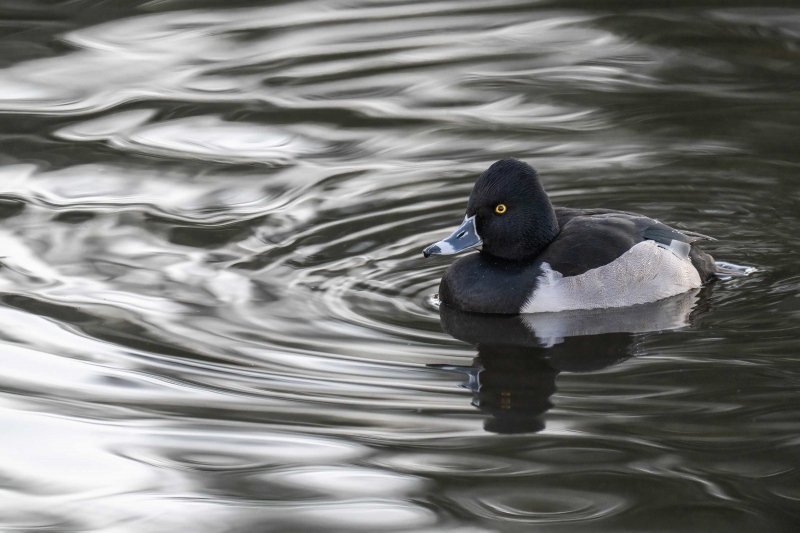
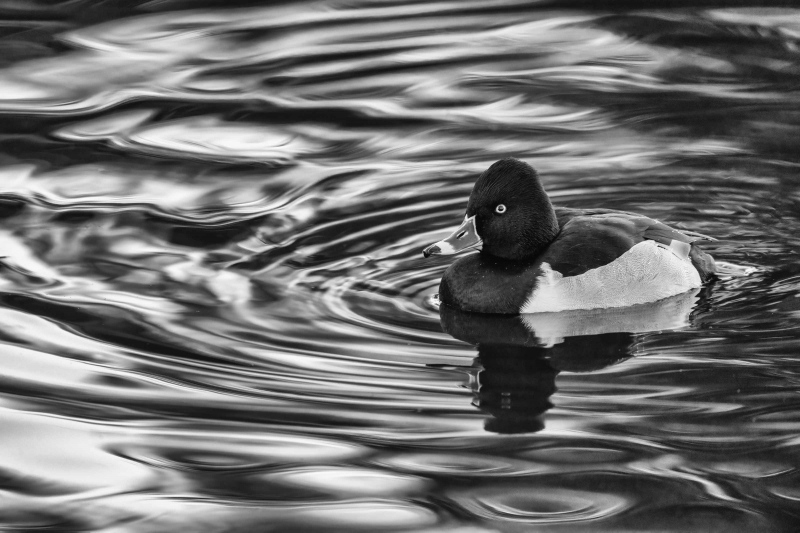
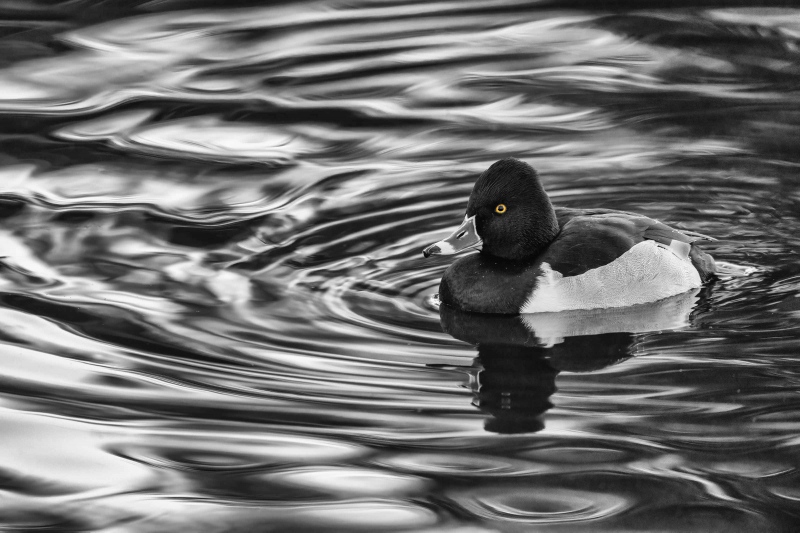
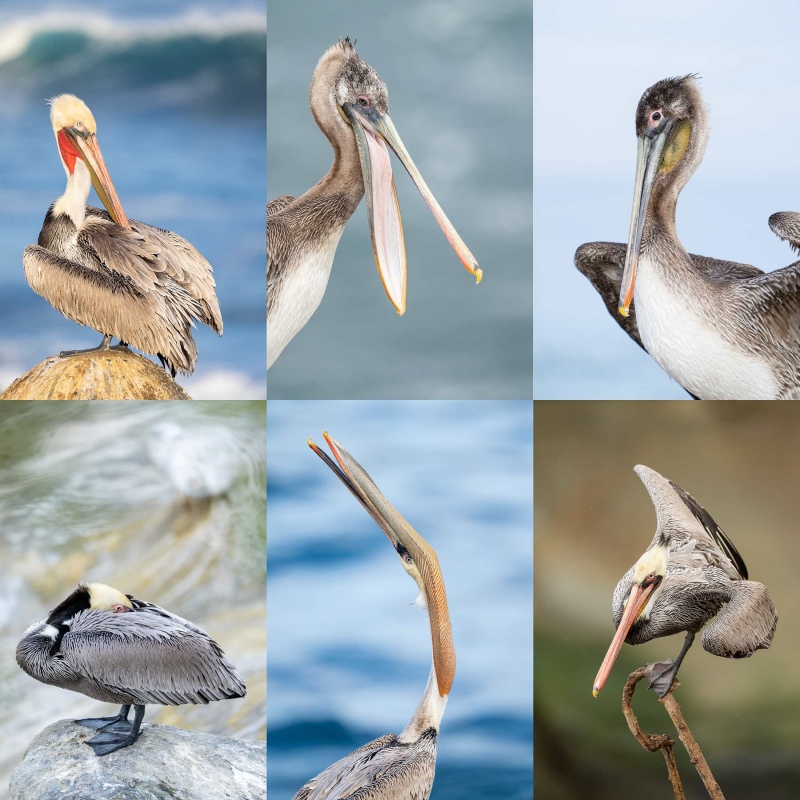
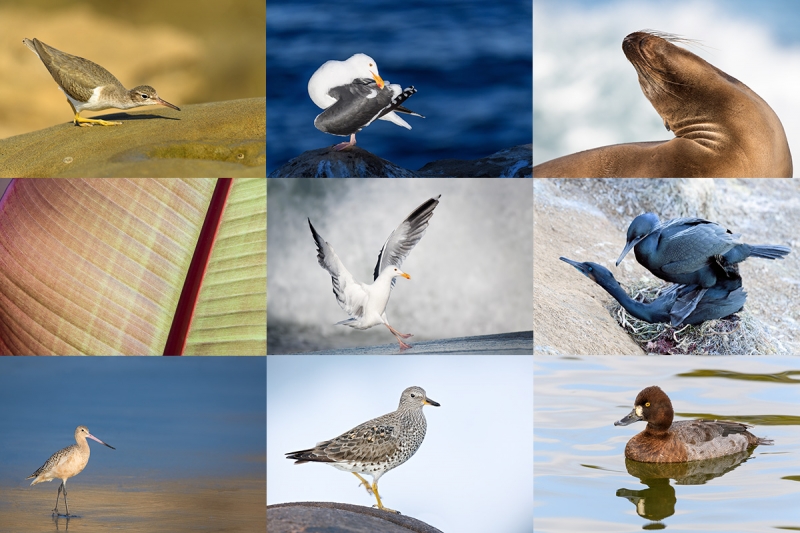

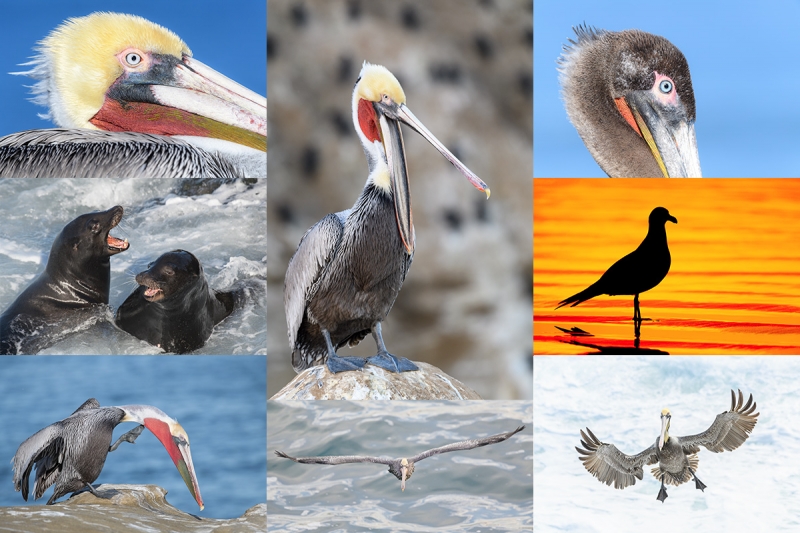














The three images of Ring-necked Duck drake swimming by John Prine are interesting. All three images are bright but Image #1 is a little more covered on face and body.
Sue, What planet are you on?
with love, artie
I discovered John Prine sadly because he was dying of covid (pre-vaccines, pre-Paxlovid or Remdesivir). I wish I’d known about him sooner. As for the ring-necked duck, I like all three images but slightly prefer the full-color one. Some ornithologist must have got thoroughly stoned (or drunk) before naming that bird. “Ring-billed” would have made sense, but you can barely even see the ring on the neck in perfect light.
Thanks, David. To set the record straight, at best, John Prine died of “complications of COVID.” He had many underlying health issues including obesity. There but for the grace of Cliff Oliver go I. Not to mention many decades of smoking.
And yes, it is difficult to see the reddish brown neck band most of the time.
with love, artie
ps: Thanks again for sending Andrew Schonbek to BAA; we had a great time on the last DeSoto IPT. And he is loving his Sony gear 🙂
I own every John Prine record. He is without a doubt one of the best songwriters ever. You may also like Guy Clark and Townes Van Zandt, both are also deceased now.
Thanks, Andrew. I will check them out now. How is life on Grand Cayman???
with love, artie
Just returned to my new Grand Cayman home after 2 weeks in Costa Rica. Need to get back at my underwater photography soon 🙂
Hey Artie, you existed 75 years without hearing or knowing about John Prine, well, I existed 80 years without knowing his music until reading your blog. Now he is in my ear whenever mowing the lawn or doing yard work. Thank you, my friend.
Thanks, Joe. I often listen to him while working on images.
with love, a